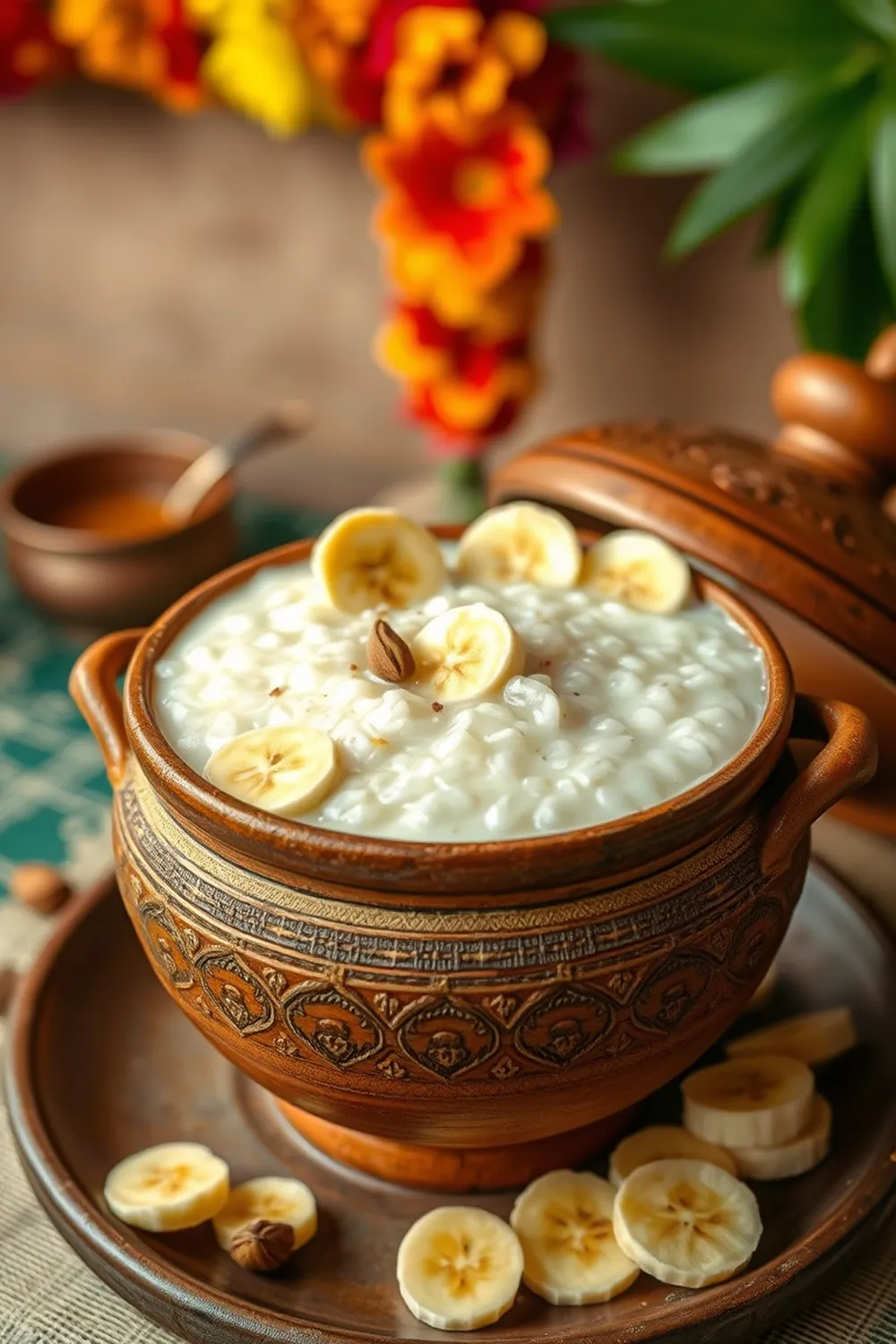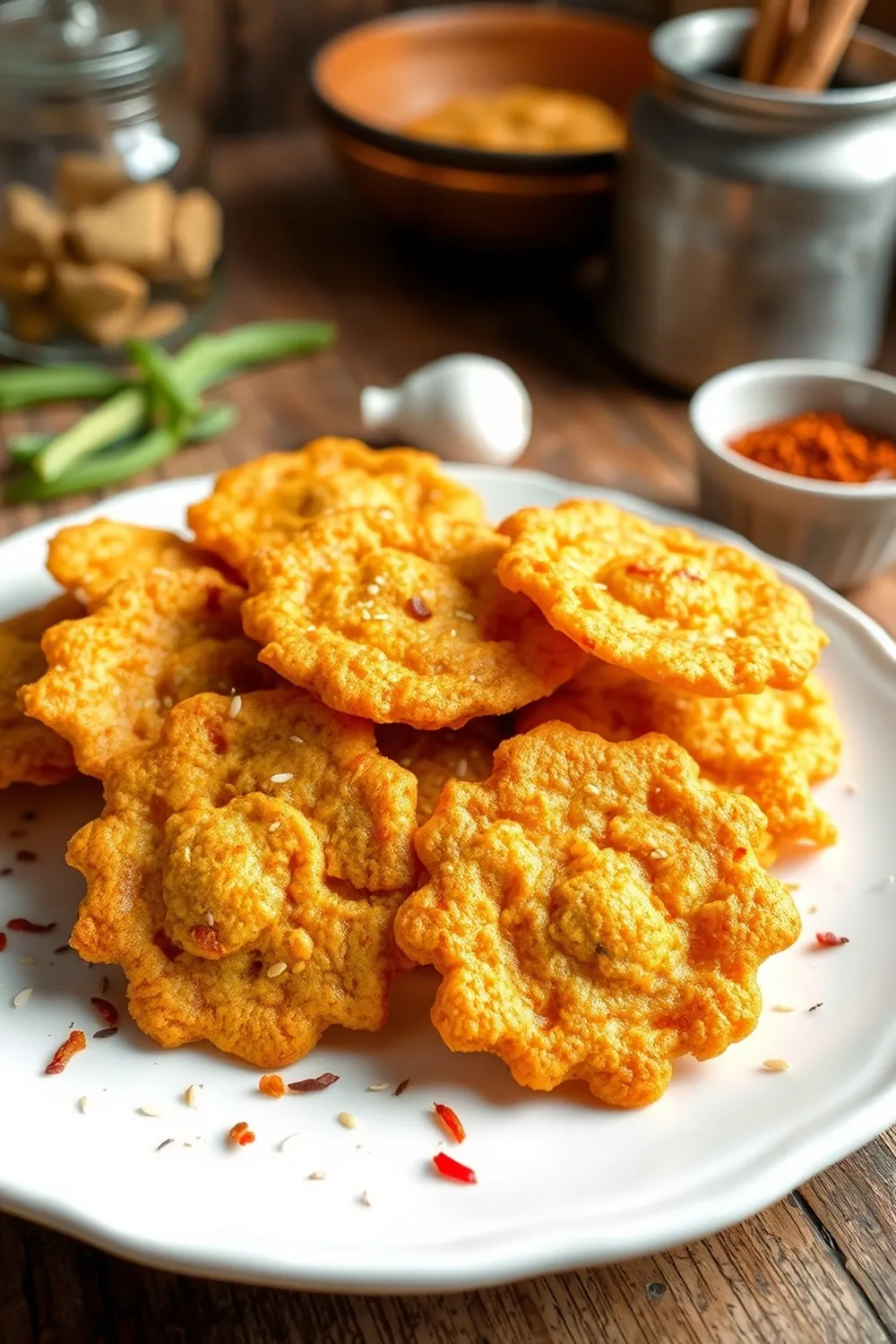- Wash and soak rice.
- Prepare jaggery syrup by boiling jaggery with water until dissolved and slightly thickened. Cool completely.
- Add drained rice to boiling milk. Cook until the rice is very soft, stirring frequently.
- Mash cooked rice lightly to thicken. Add cardamom powder.
- Filter the cooled jaggery syrup into the rice mixture. Mix well.
- Fry cashews and raisins in ghee until golden brown. Add to the payasam.
- Cool before serving or offering as naivedyam.
- Calories:496 kcal25%
- Energy:2075 kJ22%
- Protein:9 g28%
- Carbohydrates:69 mg40%
- Sugar:50 mg8%
- Salt:106 g25%
- Fat:19 g20%
Last Updated on 4 months by Neha Deshmukh
Authentic Rice Payasam Recipe – Jaggery & Cardamom Delight
Hey everyone! Today, I’m sharing a recipe that’s incredibly close to my heart – a classic Rice Payasam, also known as Kheer in some parts of India. This creamy, dreamy dessert is a staple in South Indian homes, especially during festivals. I remember my grandmother making this every Onam, and the aroma would fill the entire house. It’s pure comfort in a bowl, and I’m so excited to share my version with you.
Why You’ll Love This Recipe
This isn’t just any Payasam recipe. It’s a beautiful balance of flavors – the subtle sweetness of jaggery, the warmth of cardamom, and the richness of whole milk. It’s relatively simple to make, but the result is truly special. Plus, it’s a dish that’s often offered as Naivedyam (an offering to the deities), making it even more meaningful.
Ingredients
Here’s what you’ll need to create this delightful Payasam:
- 4 cups whole milk (approximately 950ml)
- ½ cup rice (approximately 100g) – see ‘Rice Varieties for Payasam’ below for best choices
- ½ to 1 cup jaggery (approximately 120g – 240g), depending on sweetness preference
- ¼ teaspoon ground cardamom (approximately 0.6g)
- 1 cup water (approximately 240ml)
- 2 tablespoons Ghee (approximately 30ml)
- 10-15 cashews
- 1-2 tablespoons sweet raisins (approximately 15g – 30g)
Ingredient Notes
Let’s talk ingredients! A few little things can make a big difference.
- Rice: Using the right rice is key. I’ll dive deeper into that in the next section.
- Jaggery: Jaggery adds a unique, molasses-like sweetness that sugar just can’t replicate. But, quality matters! Look for dark-colored jaggery for a richer flavor.
- Whole Milk: Don’t skimp on the milk! Whole milk gives the Payasam its signature creamy texture.
- Ghee: Ghee isn’t just for flavor; it helps with the texture and adds a lovely aroma. You can use unsalted butter if you don’t have ghee, but ghee is traditional.
- Cardamom: Freshly ground cardamom is always best. The aroma is incredible!
Rice Varieties for Payasam
Choosing the right rice is super important. Here are my go-to choices:
- Raw Rice (Pachari): This is the most traditional choice, especially in Kerala. It gives a lovely, slightly chewy texture.
- Basmati Rice: Works well too, offering a fragrant aroma. Just be careful not to overcook it.
- Sona Masoori: Another good option, readily available and cooks up nicely.
The Sweetness of Jaggery: Regional Variations & Health Benefits
Jaggery, or gur, is unrefined sugar made from sugarcane juice. It’s a staple sweetener in Indian cuisine, and each region has its own preferences. In some parts of South India, they prefer a darker, more intense jaggery, while others like it milder.
Beyond the taste, jaggery is considered healthier than refined sugar. It contains trace minerals like iron and potassium. It’s also believed to have warming properties, which is why it’s often used in winter desserts.
The Importance of Whole Milk & Ghee
Using whole milk is non-negotiable for that luxurious, creamy texture. Reduced-fat milk just won’t give you the same result. Similarly, ghee adds a richness and aroma that’s essential to a good Payasam. It also helps prevent the rice from sticking to the bottom of the pot.
Cardamom: Aromatic Spice Profile
Cardamom isn’t just a flavor; it’s an experience! It has a complex aroma – floral, citrusy, and slightly minty. A little goes a long way, so don’t overdo it. I always add it towards the end of cooking to preserve its fragrance.
Step-By-Step Instructions
Alright, let’s get cooking!
- First, wash the rice thoroughly under cold water until the water runs clear. Then, soak it in water for at least 30 minutes. This helps it cook evenly.
- In a heavy-bottomed pot, bring the milk to a boil. This is important to prevent sticking.
- While the milk is heating, prepare the jaggery syrup. In a separate pan, combine the jaggery and water. Bring to a boil and stir until the jaggery is completely dissolved. Let it simmer for a few minutes until it becomes slightly sticky. Then, remove from heat and let it cool completely.
- Drain the soaked rice and add it to the boiling milk. Reduce the heat to medium-low and cook, stirring frequently, until the rice is soft and cooked through – about 20-25 minutes.
- Once the rice is cooked, mash it lightly with the back of a spoon. This helps thicken the Payasam. Add the cardamom powder and mix well.
- Now, gently pour the cooled jaggery syrup into the rice mixture. Stir continuously until everything is well combined.
- In a small pan, heat the ghee over medium heat. Add the cashews and raisins and fry until golden brown. Be careful not to burn them! Pour this into the Payasam.
- Let the Payasam cool completely before serving. It tastes even better chilled!
Expert Tips
Here are a few things I’ve learned over the years:
- Achieving the Perfect Payasam Consistency: The consistency should be creamy and slightly flowing, not too thick or too thin. Adjust the amount of milk if needed.
- Preventing Sticking & Burning: A heavy-bottomed pot is your best friend. Stir frequently, especially during the initial stages of cooking.
- Enhancing the Cardamom Flavor: Add the cardamom powder towards the end of cooking to preserve its aroma.
Variations
Want to switch things up? Here are a few ideas:
- Vegan Payasam Adaptation: Use plant-based milk like almond or coconut milk. Substitute ghee with coconut oil.
- Gluten-Free Confirmation: This recipe is naturally gluten-free!
- Adjusting Spice Levels: Feel free to add a pinch of nutmeg or saffron for a different flavor profile. My friend loves adding a tiny bit of rose water!
Payasam for Festivals (Pongal, Onam, Diwali)
Payasam is an integral part of many Indian festivals. It’s offered as Naivedyam to the deities, symbolizing prosperity and abundance. Each festival has its own traditions surrounding Payasam – some prefer it extra sweet, others like it with more nuts.
Serving Suggestions
Serve Payasam warm or chilled. Garnish with a few extra cashews and raisins. It’s delicious on its own, but you can also pair it with other Indian sweets.
Storage Instructions
Leftover Payasam can be stored in an airtight container in the refrigerator for up to 3 days. It may thicken upon cooling, so you can add a splash of milk when reheating.
FAQs
What type of rice is best for Payasam?
Raw rice (Pachari) is the most traditional, but Basmati or Sona Masoori also work well.
Can I use sugar instead of jaggery? What adjustments should I make?
Yes, you can! Use ¾ cup of sugar for every 1 cup of jaggery. Sugar dissolves more easily, so you might need to simmer for a shorter time.
How do I prevent the Payasam from becoming too thick or too thin?
Adjust the amount of milk. If it’s too thick, add more milk. If it’s too thin, simmer for a few more minutes, stirring constantly.
What is the significance of offering Payasam as Naivedyam?
Offering Payasam as Naivedyam is a way of showing gratitude and devotion to the deities. It’s believed to bring blessings and prosperity.
Can this Payasam be made ahead of time? How long will it keep?
Yes, you can make it a day ahead. Store it in an airtight container in the refrigerator for up to 3 days.










